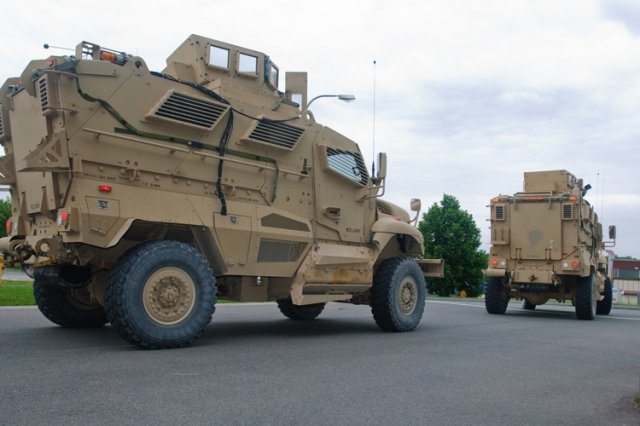The Soldier checks the indicator lights on the vehicle before turning the ignition key. The engine rumbles to life and he switches into drive. He moves forward as sleet pelts the windshield. He needs to find the wipers to see in the muddy terrain, and fumbles in the dark.
The Soldier veers slightly off the road. The vehicle tilts. The over-correction rolls the vehicle.
Light floods the room and the instructor resets the course. It’s time to try again. Grafenwoehr’s Combat Drivers Training program is the only program in Europe to train drivers for driving conditions and vehicle familiarization in Afghanistan.
The program is meant to help increase safety and decrease deadly accidents caused by unfamiliarity with the vehicle and terrain.
“It will decrease the number of accidents,” said Staff Sgt. Corey A. Burse, who works at the 7th Army Combined Arms Training Center, or CATC, in Vilseck, Germany. “You get in a vehicle you don’t know, drive down narrow roads and roll the vehicle over. That’s the number one cause of Soldiers’ deaths.”
Burse said that it is better to use the mine-resistant, ambush-protected, or MRAP, vehicle simulator to acclimate to the rough terrain downrange than to put Soldiers on the roads there with no idea of of what to expect. This way, Soldiers see how the vehicle handles and how the indicators work and feel, without putting their lives in danger or ruining equipment.
The MRAP simulator and driving practice helps Soldiers identify problems and how to adapt to different environments and situations.
Many multinational Soldiers will not have the opportunity to see an MRAP vehicle before heading downrange unless they attend the course the JMTC is offering.
The JMTC is helping to improve the Soldier’s reactions to unfamiliar situations.
“JMTC provides world-class training for Europe,” said Burse. “It is the premier training center in Europe for troops deploying.”
Pvt. Rolands Lakucs, a translator for the Latvian Army, is preparing to deploy to Afghanistan as the United States starts to reduce the number of troops that are stationed there. Lakucs said the simulation driving was useful.
“You need to know what the truck can and can’t do,” he said.
Second Lt. Argo Sibul, a platoon leader in the Estonian Army, who is deploying this fall, said that having this experience with the MRAP prior to deploying is beneficial.
“If the first time a Soldier sees this vehicle is in Afghanistan, that is where we will face problems,” said Sibul.
All of the drivers in his deploying unit are attending this training.
Sibul said that it is better to have the experience now, before leaving for Afghanistan because they are allowed a trial and error period here. What they can’t figure out during their training here, they will have to figure out in Afghanistan, where there is no room for error.
“I hope it will be saving lives. That’s why we want to use that MRAP,” said Sibul. “That is what it was designed for. It is a great resource and it was designed for the Afghan experience.”
The Soldiers pause for a few moments, some snap a photograph as they head into the MRAP for the hands-on portion of the course. For the next few hours, they will be taking turns driving the vehicle to build familiarity with the vehicle.
The hands-on portion will be different from the simulator, but JMTC has learned that the method they are using for the class does work and it is decreasing accidental MRAP deaths.
At Grafenwoehr, any unit can sign up for one of the MRAP classes. European units preparing to deploy take advantage of this resource. With the experience they receive here, the JMTC is hoping to reduce the accidental and needless deaths of Soldiers.











